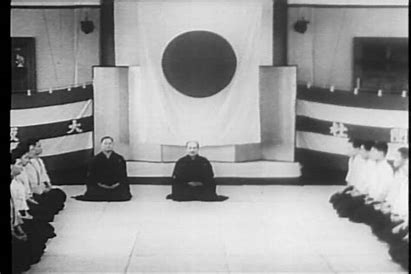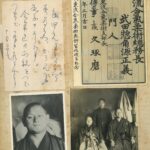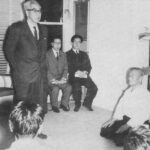As I mentioned in the previous articles, “Soden” is a transmission document that replayed and explained techniques instructed by Masters Ueshiba Morihei and Takeda Sokaku through photographs. Typically, there are only one to three photos for each Waza, which may seem minimal by modern standards, but considering the rarity of owning a personal camera in the pre-war era, taking photos for record of practicing was a luxurious endeavor.
It was just possible because of a corporate directive, they were allowed to borrow the equipment and print the photos.
From these photos, “Kamnagara no Budo” was edited based on the instructional techniques of Master Ueshiba. In Takumakai, many people call these “Kamnagara.” Furthermore, this can be a curated edition of “Soden” carefully selected by Master Hisa Takuma from the early version of “Soden.”
“Kamnagara no Budo” was authored by Hisa Takuma and published on November 11, 1940. When you flip through the cover, it states,
“Supporting the Great East Asia Co-Prosperity Sphere, dedicating oneself to the country through martial arts. Here records the secret transmission of Daitoryu Aiki Budo, a tradition had not been disclosed to the public. Written in the 2,600th year of the imperial era by Hisa Takuma”
Additionally, it mentions, “Dedicated to my respected teachers, Takeda Sokaku and Ueshiba Morihei.”
The techniques in the book covered seated techniques, half-sitting techniques, standing techniques and techniques against numerous opponents, which are totally fifty-nine techniques. At the time, it was not for sale. It also was published in conjunction with the 2,600th imperial year, possibly with the intention of participating in what would now be referred to as a millennium celebration.
What I find intriguing is the fact that in each chapter on seated techniques, half-sitting techniques, standing techniques, and techniques against numerous opponents, Master Hisa Takuma himself demonstrated the techniques at the beginning of each chapters. Interestingly, seven additional techniques filmed by Hisa himself later are not included in Soden photo records.
Speaking of which, the reasons for recording the photos known as Soden is not definitively known. According to a commonly heard story, the motivation was simple, it started as a memorandum after practice, recording for the sake of documentation. In other words, there seems to be no profound intent initially. However, as practice progressed, Master Hisa and the practitioners became captivated by the depth of Daitoryu. It is speculated that they eventually recorded over 1,500 photos, organizing them with explanations of the techniques.
Incidentally, at that time, Master Hisa himself would show utmost respect in the teacher-disciple relationship, accompanying his master even after practice and guiding him to the bath after every practices. Since the remaining members were demonstrating techniques for photographs, it was natural that Master Hisa, as the responsible figure, could not participate in those photo sessions. As a result, Master Hisa is entirely absent from the photos demonstrating techniques in “Soden.” This might have been a source of genuine regret for Hisa. In the compilation of “Kamnagara no Budo,” there is a dedication as he took new photos, demonstrating techniques in formal attire with his family crest, reflecting a profound sentiment.
Here I would like to review significant events on Master Hisa’s timeline.
From 1934 to 1936, practiced under the guidance of Master Ueshiba Morihei.
In 1935, a documentary “Budo” was filmed.
From 1936 to 1939, practiced under the guidance of Master Takeda Sokaku.
On March 26, 1939, Hisa Takuma received Menkyo Kaiden permission.
In November 1940, “Kamnagara no Budo” was published.
Notably, the film “Budo” was produced in 1935, this means predating Hisa Sensei’s encounter with Master Takeda Sokaku.
What I find important is that we can see Master Ueshiba Morihei demonstrating Daitoryu in this film. Fortunately, during the same period when he was teaching Daitoryu to Hisa and his members, they shot a film of him demonstrating Soden techniques (although Master Ueshiba didn’t explicitly use the term “Daitoryu” at that time).
Actually, I used to think that Soden Waza should be executed in a precise, fixed and formalized form of repeating stop and move, similar to typical classical Budo kata, because that’s how they appear in the photos of Soden. However, upon closer reflection, I realized that photos merely represent a frame-by-frame replay. There is no intention in the photograph to instruct one to pause at specific points, it simply captures moments for explanatory purposes. (I will write about this topic later under the title “Forms of “Kaisho”(Regular Script) and “Sosho”(Cursive Script) of Calligraphy”).
When considering another perspective, it is said that Master Ueshiba Morihei was invited from Tokyo to Osaka Asahi Newspaper headquarters during a time of increasing unrest, possibly to prepare for the prevailing circumstances. The participants in the training at that time were not just ordinary martial artists, they were skilled practitioners of sumo, judo or some other martial arts. Given this context, it’s difficult for me to imagine that the training conducted in Asahi at that time was focused on learning the forms of a school-like way to inherit ancient forms. Although this is purely a personal speculation, what was sought during that time was the swift and efficient Waza to employ versatile techniques to overcome enemies.
I believe the answer to these questions lies in this Enbu of Master Ueshiba in this film. The extraordinary skills of Master Ueshiba, which seem to foreshadow the origins of Aikido, is shining in this film.
Moreover, it seems that Soden photos were compiled shortly after the completion of “Kamnagara”.
During the same period, Master Ueshiba Morihei organized Koubukai in 1940, then entrusted its Tokyo dojo to his son Kisshomaru in 1942, he then relocated to a rural area, Iwama in Ibaraki Prefecture. At that time he was at the age of 59. On the other hand, Master Sokaku passed away at the age of 84 during a journey in Aomori in 1943. In the same year, Master Hisa himself retired from Asahi at the age of 48. Additionally, in that same year, Master Nakatsu Heizaburo suffered a stroke and returned to his hometown of Awa Ikeda in Tokushima.
The social situation was marked by the Pacific War, which began with the attack on Pearl Harbor in December 1941, and continued until the end of World War II in 1945. After then, the post-war period was marked by GHQ’s Japanese traditional martial arts ban, making the compilation of Soden a challenging task amidst adversity. It might be my wild exercise in imagination. One can sense the strong determination of Master Hisa in this endeavor.
However, it wasn’t until July 1957 that Master Hisa, in this role as successor, established the “Kansai Aikido Club” in Hiranocho, Osaka. I will write about anecdotes from this period someday. In old Takumakai newsletters, there were articles by Master Hisa himself, along with stories contributed by his daughter, Ms. Yorita Kiyoko, and Ms. Wada Yoko.
On a side note, the title characters of this website were processed from Master Hisa’s handwritten certification to Master Mori Hakauru.


